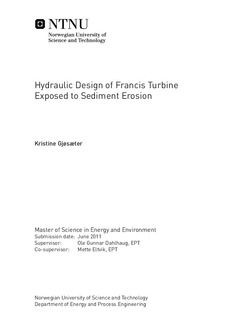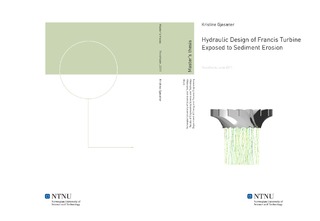| dc.description.abstract | Sediment erosion is a large problem for turbines operated in sand laden water, especially in the Himalayas and the Andes Mountains, where the contents of hard minerals in the rivers are high. A program called RenewableNepal supports the development of a new design philosophy for hydraulic turbines. NTNU and Kathmandu University cooperate within this program, and this master thesis is part of that cooperation.The objective of this thesis is to carry out the hydraulic design of a Francis turbine with reduced velocities. As part of that, a design software has been developed, using Matlab as programming tool. This software has been used to generate a reference design with the same physical dimensions as for the existing runners at Jhimruk Hydrorelectric Centre in Nepal. CFD analysis has been performed to verify the design software output, showing good results. Analysis of erosion from CFD were not successful as mesh independency for the analysis could not be established. Hence results for erosion prediction from CFD studies has not been presented in this thesis.A parametric study has been carried out, varying either the outlet diameter, the number of pole pairs, the inlet velocity, the acceleration of the flow through the runner, the height of the shroud or the blade angle distribution. An erosion model was implemented in the design software, and used as a control variable for the parametric study. CFD analyses using Ansys CFX were performed for selected designs with lower erosion than the reference design. The largest reduction of erosion was obtained when increasing the number of pole pairs, which implies that the rotational speed of the turbine is decreased. This does however increase the size of both the turbine and the generator, which cause increased investment costs as well. CFD analysis shows that the hydraulic efficiency for this design is higher than for the reference design. It was also discovered that by changing the blade angle distribution, and consequently also the energy distribution, a substantial reduction of erosion was possible without changing the physical dimensions or the rotational speed of the turbine. The efficiency for this design is also higher than for the reference design. The most promising design was found as a combination of these two effects, giving a reduction of the erosion of 50 percent compared to the reference design. CFD analysis for this design show a good efficiency and acceptable flow conditions in the runner. This and other designs with the modified blade angle distribution will have an unconventional energy conversion through the runner, leading to larger hydraulic forces on the trailing edge of the blades. Strength analyses of the blade would be beneficial, but have not been performed.The main focus in this thesis has been on developing the design software and developing runner designs for reducing sediment erosion. There have been no attempts for optimizing the designs of the guide vanes and stay vanes due to time constraints. | nb_NO |

